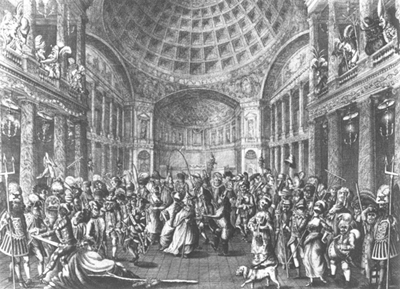

"here, in one confusion herl'd,
seem all the nations of the world,
Cardinals, quakers, judges dance;
Grim Turks are coy, and nuns advance,
Grave churchmen here at hazard play;
So for his ugliness more fell,
Was H-d-g-r toss'd out of hell,
And in return by Satan made
First Minister of masquerade."
from "The Masquerade" by Henry Fielding [1]
Like most functions which break barriers of class, gender, and ethnicity by challenging social norms, the eighteenth-century masquerade had strong and vocal opponents. The anti-masquerade movement was primarily led by clergymen, pamphleteers and journalists who held the belief that the masquerade was a threat to English morals [2]. The clergymen preached to the members of their congregations about the "evils of the masquerade" in their sermons, the pamphleteers passed out information to people on the streets about the corruption that occurred at the masked balls, and the journalists (whose papers printed tickets and advertisements for the very masquerades they claimed to oppose) wrote scathing editorials against the reveling masqueraders. "Middle-class moralist" such as Henry Fielding, Samuel Richardson and Eliza Haywood also aligned themselves with the anti-masquerade movement. They showed their demonstration against the function of the masquerade through their fictional writing and artistic expression [3].
Perhaps influenced by the cultural popularity of the masquerade at the time, the civil authorities, on the other hand, were torn between inconsistent policies of tolerance for the masquerade and occasional efforts to suppress them [4]. Masked parties were only occasionally broken up by civil authorities. The Weekly Journal for April 10, 1775 describes those in attendance of one forcibly broken up masquerade as a gathering of "Chamber-Maids, Cook-Maids, Foot-Men, and Apprentices" [5]. It seems that, on the rare occasion that a masquerade was broken up by civil authorities, it was more likely that the event had been hosted by those of the working class rather than by the more prominent people in England's "fashionable society."
 Throughout
the eighteenth century, one of the primary efforts of the anti-masquerade
movement was to distance England from any association with the invention of
the masquerade. Its most ardent critiques viewed the masquerade as an epidemic
that had infected the shores of England. Referring to masquerades in An
Enquiry into the Causes of the Late Increase of Robbers, Henry Fielding
wrote that, "bad Habits are infectious by Example, as the Plague itself by
Contact" [6]. Many opponents of the masquerade looked to
the foreign influence of other European nations such as Italy and France and
the Orient as the diabolical source of the "cultural epidemic" which they
believed was invading both the morality and the national pride of England
[7]. In his 1724 sermon against the masquerade, the Bishop
of London blamed the presence of the masquerade in English society on a certain
"Ambassador of a neighboring Nation." He went on to preach that the masquerade
was a plot devised by France to "enslave true Englishmen by encouraging in
them Licentious and Effeminacy" [8]. One journalist opponent
of the masquerade wrote in the April 19, 1718 Weekly Journal that masquerades
were imported from "hot Countries (notorious for Lewdness)" and were England's
interpretation of the carnivals of "Venice, Rome, and Spain" [9].
Those in the anti-masquerade movement also had several "conspiracy theories"
about why the masquerade had been introduced into English society from their
foreign neighbors. In the January 25, 1724 issue of the Weekly Journal another
writer made an even more interesting claim about the "masked" origin of the
masquerade in England. He wrote, "this Diversion has been propagated amongst
us, since the Nation has been honor'd with the Residence of a Number of Foreigners."
He continues by claiming that this "foreign Diversion" was a conspiracy on
the part of foreign nations to neutralize the beauty of English women by forcing
them to "hide their charms with a mask" [10].
Throughout
the eighteenth century, one of the primary efforts of the anti-masquerade
movement was to distance England from any association with the invention of
the masquerade. Its most ardent critiques viewed the masquerade as an epidemic
that had infected the shores of England. Referring to masquerades in An
Enquiry into the Causes of the Late Increase of Robbers, Henry Fielding
wrote that, "bad Habits are infectious by Example, as the Plague itself by
Contact" [6]. Many opponents of the masquerade looked to
the foreign influence of other European nations such as Italy and France and
the Orient as the diabolical source of the "cultural epidemic" which they
believed was invading both the morality and the national pride of England
[7]. In his 1724 sermon against the masquerade, the Bishop
of London blamed the presence of the masquerade in English society on a certain
"Ambassador of a neighboring Nation." He went on to preach that the masquerade
was a plot devised by France to "enslave true Englishmen by encouraging in
them Licentious and Effeminacy" [8]. One journalist opponent
of the masquerade wrote in the April 19, 1718 Weekly Journal that masquerades
were imported from "hot Countries (notorious for Lewdness)" and were England's
interpretation of the carnivals of "Venice, Rome, and Spain" [9].
Those in the anti-masquerade movement also had several "conspiracy theories"
about why the masquerade had been introduced into English society from their
foreign neighbors. In the January 25, 1724 issue of the Weekly Journal another
writer made an even more interesting claim about the "masked" origin of the
masquerade in England. He wrote, "this Diversion has been propagated amongst
us, since the Nation has been honor'd with the Residence of a Number of Foreigners."
He continues by claiming that this "foreign Diversion" was a conspiracy on
the part of foreign nations to neutralize the beauty of English women by forcing
them to "hide their charms with a mask" [10].
The sexual freedom many women were exposed to at the masked balls was often cited by anti-masquerade writers as an example of the decline of social morality and one of the dangers of the masquerade. These critics wrote that it was dangerous for respectable girls and women, even those escorted by a trustworthy male relative, to participate in the oftentimes "lude and explicit" gathering of the masquerade [11]. Those in the anti-masquerade movement equated attending the masquerade with the sexual act itself, thus the same double standards operating in eighteenth-century English culture about male and female sexuality translated into the discourse of those opposed to the masquerade. Although female attendance at the masquerade was viewed as a heinous, criminal offence, though not condoned, male attendance was more or less tolerated by the critics of the masked balls. In The Female Spectator Eliza Haywood advised her female readers that "women of honour" not only did not attend the masquerade but "shunned the deprave gentlemen who were so depraved as to offer them tickets" [12]. On the other hand, she advised her male readers not against going to the masquerade themselves but against bringing their wives or sisters with them lest their mistress might also be in attendance [13].
The anti-masquerade movement moved beyond the small-scale efforts of writers, journalist and pamphleteers to stop the perceived moral downfall of English society after the 1755 earthquake in Lisbon. On November 1, 1755 an earthquake destroyed major parts of the city of Lisbon resulting in a devastating loss of many lives [14]. People in London were deeply affected by the news of the reported tragedy and devastation that had occurred in Lisbon. After the earthquake, supporters of the anti-masquerade movement spoke out publicly against the masquerade. They claimed that the tragedy of the Lisbon earthquake occurred as a result of the sin and corruption that had been infecting not only English culture but also the culture of the world for many years. They preached their belief that one of the greatest expressions of this sin and corruption was the masquerade and called for public condemnation of these events. As a result of these public outcries, the masquerades were forbidden to take place throughout the following year [15].
By the end of the eighteenth century the masquerade suffered a distinct decline in popularity. In her comprehensive study on the eighteenth-century English masquerade, Masquerade and Civilization, Terry Castle explains that the discourse of the anti-masquerade movement which exposed the masquerade as "a threat to bourgeois decorum and national taxonomies" could actually help explain the cultural implications of the decline of the masquerade. She writes, "Mask and costume, the signs of joyful exchange between self and other, had to be laid aside, and more sober pursuits embraced. By the end of the eighteenth century, this transvaluation of pleasure had in fact been achieved: pleasure resided no longer in a magical incorporation of the other, but in the sentimental objectification of the other" [16]. In the end, it seems, it was a changing world rather than a "world turned upside-down," that led to the extinction of the masquerade in eighteenth-century England.
Endnotes
1. 2. Ribiero, Aileen. The Dress Worn at
Masquerades in England 1730 to 1790.
New York, NY: Garland Published, 1984, 4.
2. Castle, Terry. Masquerade and Civilization: the Carnivalesque
in Eighteenth-Century
English Culture and Fiction. Stanford, CA: Stanford
University Press, 1986, 95.
3. Castle, 95.
4. Castle, 95.
5. Castle. 96.
6. Castle, 85.
7. Castle, 7.
8. Castle, 7.
9. Castle, 8.
10. Castle, 8.
11. Castle, 43.
12. Castle, 43
13. Castle, 43.
14. Ribiero, 6.
15. Ribiero, 6.
16. Castle, 107.